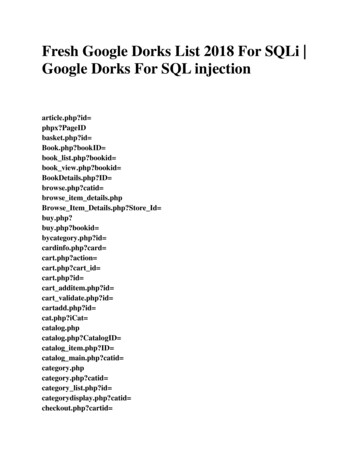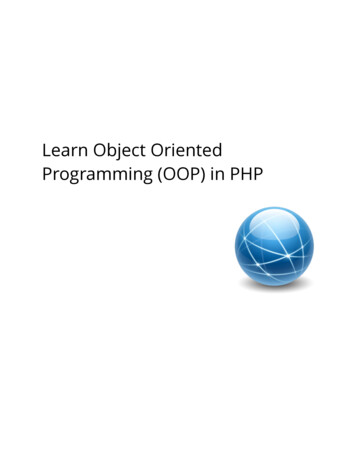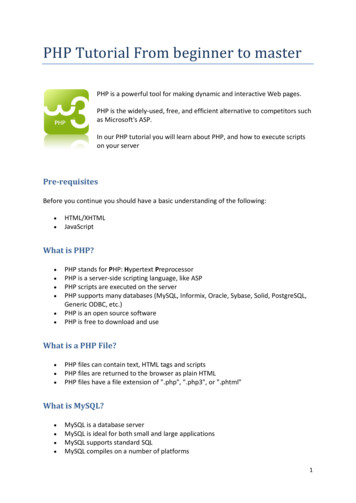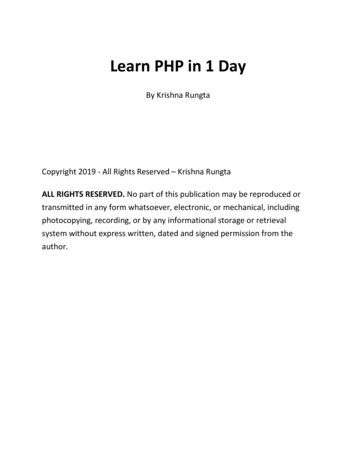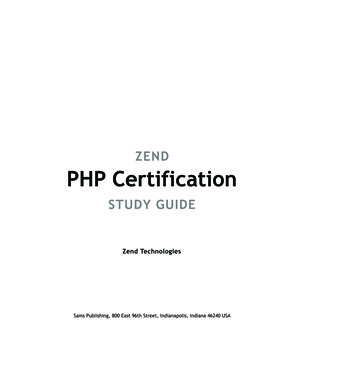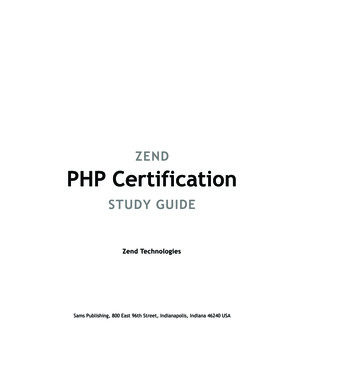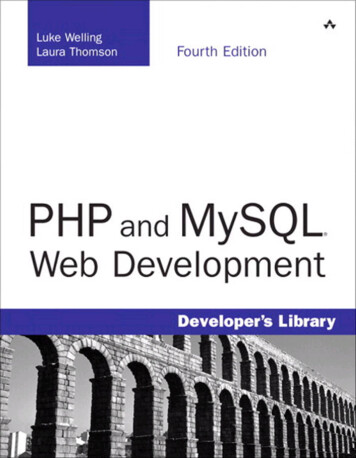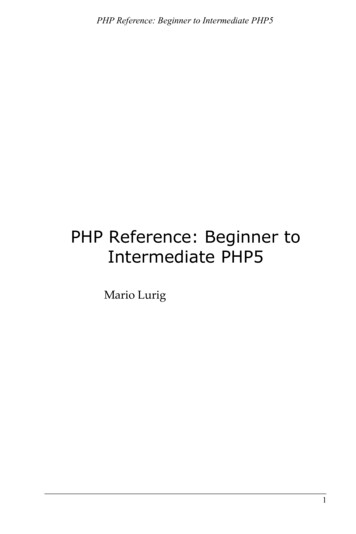
Transcription
PHP Reference: Beginner to Intermediate PHP5PHP Reference: Beginner toIntermediate PHP5Mario Lurig1
Mario LurigPHP Reference:2008Beginner to Intermediate PHP5ISBN: 978-1-4357-1590-5Creative Commons Attribution-NonCommercial-ShareAlike 2.0You are free:to Share — to copy, distribute and transmit the workto Remix — to adapt the workUnder the following conditions: Attribution. You must attribute the work in the manner specified by theauthor or licensor (but not in any way that suggests that they endorse you oryour use of the work). Noncommercial. You may not use this work for commercial purposes. Share Alike. If you alter, transform, or build upon this work, you maydistribute the resulting work only under the same or similar license to thisone. For any reuse or distribution, you must make clear to others the licenseterms of this work. Any of the above conditions can be waived if you get permission from thecopyright holder. Nothing in this license impairs or restricts the author's moral rights.FIRST EDITIONhttp://www.phpreferencebook.comCover art credit (PHP REFERENCE:), included with permission:Leo Reynolds ( www.flickr.com/lwr/ ) - 7 imagesPatrick Goor ( www.labworks.eu ) - 3 imagesEva the Weaver ( www.flickr.com/evaekeblad/ ) - 2 imagesDuncan Cumming ( www.flickr.com/duncan/ ) - 1 image2
PHP Reference: Beginner to Intermediate PHP5ContentsPreface.5Miscellaneous Things You Should Know.9Operators.19Control Structures.25Global Variables.33Variable Functions.35String Functions.41Array Functions.71Date/Time Functions .103Mathematical Functions.111MySQL Functions.115Directory & File System Functions.127Output Control (Output Buffer).139Sessions.145Regular Expressions .149Common Language Index.159Function Index .161.3
Mario Lurig4
PHP Reference: Beginner to Intermediate PHP5PrefaceI taught myself PHP and MySQL and found myself, at times,without internet access and thus without search access to the PHP.netmanual ( http://www.php.net/manual/en/ ). Since coding was not myprimary job, I needed a refresher on syntax, usage, and most of all, areminder of how to code PHP without spending an hour debugging a sillymistake. I printed out reference sheets, cards, cheat sheets and tried to workoff of them exclusively. However, I still found myself needing more thanwould fit on one page of 8.5" x 11" paper front and back. So, off I went to theweb and the local bookstore. After spending some time with a few books,giving them a trial run, I ran into two major problems:1.I spent most of the time weeding through extensive tutorials to findthe keyword and answer I was looking for, sometimes fruitlessly.2. Information was biased or surrounded by irrelevant and oftenconfusing code that did little to explain the what of the function.I figured I couldn't be the only one with this problem, and quicklyfound out that I wasn't alone thanks to a chance run-in at a local bookstore.Casual PHP programmers, sometimes away from the internet, wanting aquick reference book that assumes they have some experience with PHP andunderstood the basics while still needing a little clarification sometimes onthe details. Therefore, this book was born.For this edition, I decided to eliminate some of the more advancedaspects of PHP programming: object oriented programming, imagemanipulation/creation, secondary modules, and a few others. Secondarily,items such as mail handling, file manipulation, regular expressions, MySQL,sessions, and cookies were balanced for complexity and usability, usuallyexcluding the more advanced uses, such as streams . Finally, this book is notan exhaustive collection of every PHP function, but a majority selection ofthose appropriate for beginner to intermediate programmers. The mostcommon or effective functions are included and some aliases are left out toreduce confusion, such as including is int() and not is long().5
Mario LurigA few bits of nomenclature should be addressed and provided, tobetter understand the word/code used inside this book. In other words, hereare some assumptions made inside this book that you should understand:expr – An expression (e.g. x 1), including boolean variable – A string, integer, float, array or boolean1 scalar - A string, integer, float, or boolean string – A string variable or its equivalent ( e.g. "string" or 'string' ) array – An array variable or its equivalent ( e.g. array( 'one' , 'two' , 'three' ) )key – Represents the key (integer or string) of an array ( e.g. array[key] )value – In relation to an array, represents the variable value ( e.g.array( 'value ') )This book also shows all code using procedural PHP and standardsyntax. However, you will find many tips will include the alternative syntaxfor control structures as to better allow you, the reader, to choose whicheveryou would prefer. Here is an example of both:// Standard syntaxif ( x 1) {echo 'Hello World!';} else {echo 'Goodbye World!';}// Alternative syntaxif ( x 1):echo 'Hello World!';else:echo 'Goodbye World!';endif;Furthermore, the use of whitespace and indenting is for clarity and iscompletely up to your preference. Styles vary greatly in the community, soplease be aware that the use of spaces or whitespace does not directly affectthe PHP code.The majority of the book is a collection of functions, theirdescriptions, example code, maybe an extra tip, and some related functionsthat may be of interest. All sample code will be accompanied by the sampleoutput, and the output will have a gray background. The definition andexample section is separated from the extraneous tip section by the use ofthree black clovers, centered on the line. It is meant as a simple visual clue tokeep one from getting distracted or lost and confusing the next bit ofinformation as required reading. All functions will be presented using thefollowing formatting:1 Boolean is usually used within an expression. While it is also evaluated as a variable, outputresults may vary and are noted within specific functions whenever possible6
PHP Reference: Beginner to Intermediate PHP5function name(input, [optional input])Description/definitionExample:Code with // commentsOutput of code as seen through a web browser's outputSee Also:function – simplified and relevant definitionfunction – simplified and relevant definition {Optional Section} Tip to help with usage or trick on using itExtra coderelated to the tipOutput{[0] Of[1] Code}Thanks, and enjoy the show!7
Mario Lurig8
PHP Reference: Beginner to Intermediate PHP5Miscellaneous Things You Should KnowNot everything fits into a neat little category, nor does everything inPHP belong in this reference book. However, sometimes they deserve aquick note and a little attention and shall be included here.PHP CodeFor portability and compatibility, always use the long form.Long form: ?php expr ? Short form: ? expr ? Short form equivalent of ? echo expr ? Note: No closing semicolon (;) is required. ? expr ? Semicolon ( ; )All statements must end in a semicolon ( ; )! Otherwise, errors will begenerated. If the error doesn't make sense, you probably are missing asemicolon somewhere!Quotations' ' (single quotes) – Content inside single quotes is evaluated literally.Therefore, string actually means: (dollar sign)string, and does not representthe variable's value.Example: string 'Single Quotes';echo ' string'; string9
Mario Lurig" " (double quotes) – Variables inside double quotes are evaluated for theirvalues.Example: string 'Double Quotes';echo " string";Double QuotesBackslash (Escape Character)Escapes characters that should be evaluated literally when inside doublequotations.Example: string 'Double Quotes';echo "\ string is set as string"; string is set as Double QuotesSpecial Charactersbackslash ( \ )question mark ( ? )single ( ' ) quotesdouble ( " ) quotesdollar sign ( )Example: string 'Hello World!';echo "The variable \ string contains \' string \' \" \\";The variable string contains \' Hello World! \' " \echo 'The variable \ string contains \' string \' \" \\';The variable \ string contains ' string ' \" \CommentsSingle line, for everything to the right of the double forward slashes:// This is a commentMultiple lines, opening and closing tags:/**//* This isa comment */10
PHP Reference: Beginner to Intermediate PHP5Formatting Characters\n –New lineCarriage return\t – Tab\b – Backspace\r –define(name, value [, boolean])name – stringvalue – scalar boolean – [optional] default: FALSE, case-sensitiveDefine a constant, a set value that is assigned globally, making it available tofunctions and classes without passing them directly as an argument.Examples:define('HELLO', 'Hello World!');echo HELLO;Hello World!define('GREETINGS', 'Hello World!', TRUE);echo GREETINGS;echo greetings;Hello World!Hello World!Functionsfunction functionname([arguments]) { }Functions can be placed anywhere in a page and will be available even ifcalled above the actual function being created. The exception to this rule is ifthe function is only defined as part of a conditional statement, and is notavailable to be called until that conditional statement has been evaluated.Examples:hello();// Above the conditional statement, this will cause an errorif (0 0){function hello(){echo 'Hello!';}}Fatal error: Call to undefined function hello()11
Mario Lurigif (0 0){function hello(){echo 'Hello ';}}hello();there();function there(){echo 'there';}Hello thereFunctions can have no arguments (as above), arguments passed to them, ordefault arguments with passed arguments as optional. The argument namesare used within that function as variable names.function args( a, b){// Has no default values, requires two inputsecho "a a, b b";}args(1,2);a 1, b 2Some examples using the following function:function args( a 1, b 2){// Has default values set c a b;echo "a a, b b, a b c";}args();a 1, b 2, a b 3args(5,5);a 5, b 5, a b 10args(10);a 10, b 2, a b 12args( DoesNotExist,20); // Do not do this, send (NULL,20) insteada , b 20, a b 20Functions can also return a variable (including an array):function Add( one, two){ total one two;return total;} a 2; b 3; result Add( a, b); // Assigns the value of total to resultecho result;5 12
PHP Reference: Beginner to Intermediate PHP5If multiple pages will refer to the same functions, create a separatefunctions.php file (name it whatever you like) and require() orrequire once() with pages that will need to use those functions. For speedand file size, page specific functions should be included directly on thenecessary page.exit([ string])die([ string])Stops the current script and outputs the optional string.Example: result @mysql connect('db', 'user', 'pw')or die('Unable to connect to database!');echo 'If it fails, this will never be seen';Unable to connect to database!Note: The above output would only display if it failed. If the @ was not presentbefore mysql connect(), PHP would output a warning as well.eval( string)Evaluates a string as if it was code. This can be used to store code in adatabase and have it processed dynamically by PHP as if it were part of thepage. All appropriate aspects of code must be included, such as escapingitems with a backslash (\) and including a semicolon (;) at the end of thestring.Example: name 'Mario'; string 'My name is name.'; // Note the single quotesecho string; code "\ evalstring \" string \" ;";// Effect of backslash escape: code " evalstring " string " ;";eval( code); // eval( evalstring " My name is name " ;);// evalstring is the same as string, except with double quotes nowecho evalstring;My name is name. My name is Mario.sleep( integer)Pauses PHP for integer amount of seconds before continuing.Example:sleep(2); // pause for 2 seconds13
Mario Lurigusleep( integer)Pauses PHP for integer amount of microseconds before continuing.Example:usleep(1000000); // pause for 1 seconduniqid([ scalar [, entropy]])entropy – [optional] boolean default: FALSE, 13 character outputGenerate a unique ID based on the scalar. If no input is given, the currenttime in microseconds is used automatically. This is best used in combinationwith other functions to generate a more unique value. If the scalar is anempty string ('') and entropy is set to TRUE, a 26 character output is providedinstead of a 13 character output.Examples: id uniqid();echo id;47cc82c917c99 random id uniqid(mt rand());echo random id;63957259147cc82c917cdb md5 md5( random id);echo md5;ea573adcdf20215bb391b82c2df3851fSee Also:md5() – MD5 algorithm based encryptionsetcookie(name [, value] [, time] [, path] [, domain] [, secure] [, httponly])name – stringvalue – [optional] stringtime – [optional] integer default: till the end of the sessionpath – [optional] string default: current directorydomain – [optional] string default: current domain (e.g.http://www.example.com)secure – [optional] boolean default: FALSE, does not require a secureconnectionhttponly – [optional] boolean default: FALSE, available to scriptinglanguages14
PHP Reference: Beginner to Intermediate PHP52Sets a cookie , visible to the server on the next page load. To send thendefault value, use a set of single quotes ('') for each argument you want toskip except the time argument, which should use 0 to send the default value.In most cases, providing the name, value, time, and domain will cover mostuses (with '' for path).Examples:setcookie('Cookie','Set till end of this session',0);// This will display properly after the page has been reloadedprint r( COOKIE);Array ( [Cookie] Set till end of this session )setcookie('Cookie','Set for 60 seconds for all subdomains ofexample.com, such as www., mail., etc.',time() 60,'','.example.com');print r( COOKIE);Array ( [Cookie] Set for 60 seconds for all subdomains ofexample.com, such as www., mail., etc. )Some common times used for expiration:time() 60*60*24 is equal to 1 daytime() 60*60*24*30 is equal to 30 daystime()-1 is one second in the past, used to expire/delete a cookiesetcookie('Cookie','',time()-1);// expires the Cookie named 'Cookie'. Note the empty string for valueurlencode( string)Changes the formatting of string to the proper format for passing through aURL, such as part of a GET query, returning the new string.Example: string 'Hello There! How are you?';echo urlencode( string);Hello There%21 How are you%3Furldecode( string)Changes the formatting of string from the URL compatible (such as a GETquery) format to human readable format, returning the new string.Example: string 'Hello There%21 How are you%3F';echo urldecode( string);Hello There! How are you?2 Must be sent prior to any headers or anything else is sent to the page (including the html tag). See ob start() for an easy way to make this work15
Mario Lurigget magic quotes gpc()Returns 0 if it is off, 1 otherwise.Used to determine if magic quotes is on. This check is used for codeportability and determining if the addition of backslashes is necessary forsecurity purposes and preventing SQL injection. Magic quotes gpcprocesses GET/POST/Cookie data and, if turned on, automatically processesthe above data every time with addslashes().Example:if (get magic quotes gpc()){echo 'Magic Quotes is on!';}else{echo 'Magic Quotes is NOT on, use addslashes()!';}// This is the default setting for PHP5 installationsMagic Quotes is NOT on, use addslashes()!See Also:addslashes() – Add backslashes to certain special characters in a stringstripslashes() – Remove backslashes from certain special characters in astringphpinfo([option])option – [optional] Used with a specific integer or string to display only aportion of phpinfo(). Specific options excluded for simplicity.By default, phpinfo() will display everything about the PHP installation,including the modules, version, variables, etc.Example:phpinfo();Display All PHP Errors and WarningsTo catch programming errors, mistakes, or make sure that PHP is notmaking any assumptions about your code, troubleshooting is best done withall PHP errors being displayed. The following two lines of code will enablethis mode:error reporting(E ALL);ini set('display errors', '1');16
PHP Reference: Beginner to Intermediate PHP5mail(to, subject, message [, headers] [, parameters])to – stringsubject – stringmessage – stringheaders – [optional] stringparameters – [optional] stringThis uses the sendmail binary which may not be configured or availabledepending on your system/setup. This is included here for basic reference. Theconfiguration and security concerns are outside of the scope of this book.Security hp/Email InjectionExample: to 'johndoe@example.com'; subject 'Hello'; message 'Hi John Doe'; headers 'From: janedoe@example.com' . "\r\n" .'Reply-To: janedoe@example.com' . "\r\n" .'X-Mailer: PHP/' . phpversion();mail( to, subject, message, headers);exec(command [, output] [, return])command – string to execute the external programoutput – [optional] Variable name to assign all the output of the command asan arrayreturn – [optional] Variable name to assign the return status as an integer.Works only when output is also present.The function will return the last line of the executed program's output. If theprogram fails to run and both output and return are both present, return willbe most commonly set to 0 when successfully executed and 127 when thecommand fails.Example (Linux specific program): lastline exec('cal', output, return);echo ' pre '; // For better formatting of print r()print r( output);var dump( lastline, return);Array([0][1][2][3] March 2008 Su Mo Tu We Th Fr Sa 1 2 3 4 5 6 7 817
Mario Lurig[4][5][6][7] 9 10 11 12 13 14 15 16 17 18 19 20 21 22 23 24 25 26 27 28 29 30 31)string(5) "30 31"int(0)header( string [, replace flag] [, http response code])replace flag – [optional] boolean default: TRUE, replace similar headerhttp response code – [optional] integerSends an HTTP header specified as string.Note: Header() must be used prior to any other output is sent to the user/browser.Use ob start() to workaround this.Examples:header('Location: http://www.someotherplace.com');// Redirects the user to the provided URLheader('HTTP/1.0 404 Not Found');// Sends the HTTP status code 404See Also:ob start() – Start the output bufferClasses & Object Oriented PHPWhile this is outside of the scope of this book, I have included a few noteshere on basic usage to extend the flexibility of this book.Class Structure: ( brackets[] delineate optional syntax )class class name [extends base class]{var variable name; // Defines a variablefunction function name([arguments]) {// Stuff to do goes here}}Refer to the containing class – use the reserved variable thisDeclare a class: variable new class name();Creating an object: variable- function name();Static call to an object:class name::function name();18
PHP Reference: Beginner to Intermediate PHP5OperatorsWhen comparing or processing variables and other values you useoperators. Without them, PHP would be more of a word jumble instead of alanguage. In some unique cases, operators slightly alter the relationshipbetween two variables or their function within PHP. Without further adieu,here they are.Basic OperatorsAdd ( ): a 1; a a 5; // a is equal to 6Subtract ( - ): s 10; s s - 5; // s is equal to 5Multiply ( * ): m 2; m m * 10; // m is equal to 20Divide ( / ): d 20; d d / 5; // d is equal to 4Modulus ( % ) Provides the remainder after division: u 5; u u % 2; // u is equal to 1Assignment OperatorsAdd ( ): a 1; a 5; // a is equal to 6Subtract ( - ): s 10; s - 5; // s is equal to 5Multiply ( * ): m 2; m * 10; // m is equal to 20Divide ( / ): d 20; d / 5; // d is equal to 4Modulus ( % ) Provides the remainder after division: u 5; u % 2; // u is equal to 1Concatenate ( . ) Join onto the end of a string: c 5; c . 2; // c is now a string, '52'See Also:Concatenate – Join together in succession19
Mario LurigComparison OperatorsGreater Than ( ): 2 1Less Than ( ): 1 2Greater Than or Equal To ( ): 2 2Less Than or Equal To ( ):2 23 22 3Short-Hand Plus or Minus oneAlso known as:Increment ( integer ; )Decrement ( integer--; )Example: a 1; a a 1; // a is now equal to 2 a ; // a is now equal to 3 a--; // a is now equal to 2 again, same as a a – 1;@ - Suppress ErrorsPlacing the commercial at symbol (@) before a function tells PHP to suppressany errors generated by that ing: include(DoesNotExist.txt) [function.include]: failed to openstream: No such file or directory@include('DoesNotExist.txt');// blank output below because the error was suppressed& - Pass by ReferenceReferences allow two variables to refer to the same content. In other words,a variable points to its content (rather than becoming that content). Passingby reference allows two variables to point to the same content underdifferent names. The ampersand ( & ) is placed before the variable to bereferenced.Examples: a b b echo1;& a; // b references the same value as a, currently 1 b 1; // 1 is added to b, which effects a the same way"b is equal to b, and a is equal to a";b is equal to 2, and a is equal to 220
PHP Reference: Beginner to Intermediate PHP5 Use this for functions when you wish to simply alter the original variableand return it again to the same variable name with its new value assigned.function add(& var){ // The & is before the argument var var ;} a 1; b 10;add( a);echo "a is a,";add( b);echo " a is a, and b is b"; // Note: a and b are NOT referenceda is 2, a is 2, and b is 11You can also do this to alter an array with foreach: array array(1,2,3,4);foreach ( array as & value){ value value 10;}unset ( value); // Must be included, value remains after foreach loopprint r( array);Array ( [0] 11 [1] 12 [2] 13 [3] 14 )Ternary OperatorThe Ternary Operator is a short-hand form for evaluating what to do whenan expression is evaluated as either TRUE or FALSE. The conditional returnseither the TRUE or FALSE output. Basic format is as follows:(expr) ? ValueIfTrue : ValueIfFalse ;Examples: boolean TRUE; result ( boolean) ? 'Is True' : 'Is False';echo result;Is True// result is not yet set result (isset( result)) ? result 1 : 10;echo " \ result result."; result (isset( result)) ? result 1 : 10;echo " \ result result."; result 10. result 11.21
Mario LurigThe Equal SignAssignment ( ): Assigns the value on the right to the variable on the leftEquality ( ): Checks if the left and right values are equalIdentical ( ): Checks if the left and right values are equal AND identicalExample: a 1; // Sets the value of a as 1 by assignment b TRUE; // Sets the value of b to the boolean TRUEif ( a b){echo 'a is equal to b.';}if ( a b){echo 'a is identical and equal to b.';}a is equal to b.Not ( ! ), Not Equal to ( ! ), Not Identical to ( ! )Used in conditional statements to evaluate as true a FALSE result of anexpression or if a value is NOT equal to the second value.Example: a 1;if (!isset( a)){ // If the variable a is NOT set then.echo ' a is not set'; // The expression is TRUE if it is NOT set// Since there is no ELSE statement, nothing is displayed}if ( a ! 0){echo ' a does not equal zero';} a does not equal zeroSee The Equal Sign above for equality versus identicalConcatenate (The Period)A period is used to join dissimilar items as part of a string in the same orderas they are listed. In many cases this is used to reference the value of afunction or of an array, which cannot be referenced within double quotations( "" ) when being assigned to a string variable.Example: array array( 1 'Hello' ); string 'World';echo ' string in single quotes, followed by ' . array[1] . " string"; string in single quotes, followed by HelloWorld22
PHP Reference: Beginner to Intermediate PHP5Comparison Operators (non-arithmetic)and ( && )or ( )xor ( xor ) - Or, but not AllExamples:if (1 1 && 2 2){echo 'And is True';}And is Trueif (1 1 2 2){echo 'At least one of these is True';}At least one of these is Trueif (1 1 xor 2 10){echo 'One of these is True, but not both';}One of these is True, but not both23
Mario Lurig24
PHP Reference: Beginner to Intermediate PHP5Control StructuresThe heart of PHP is the control structures. Variables and arrays arelonely without them as they facilitate comparisons, loops, and large handstelling you to go that way and do it this way. Okay, I made that last part up.Here we go!If, ElseIf, Elseif (expr)// If}elseif// If}else{// If}{expr is TRUE, do this, then exit the IF loop(expr2) {expr is FALSE, and expr2 is TRUE, do this, then exit the loopall expr's are FALSE, do this, then exitThere can be only one instance of else in an if statement, but multiple elseifexpressions are allowed prior to the else statement.Example: x 1;if ( x 1){echo ' x is less than 1';}elseif ( x 1){ // Note the double equals, for comparisonecho ' x is equal to 1';}else{echo ' x is neither equal to 1 or less than 1';} x is equal to 1See Also:switch – A simpler, more organized usage than multiple if/elseIfcombinationsbreak – Stops a loop and exits regardless of if the statement evaluates as true 25
Mario LurigAlternative syntax for an if statement:if (expr):// If expr is TRUE, do this, then exit the IF loopelseif (expr2):// If expr is FALSE, and expr2 is TRUE, do this, then exit theloopelse:// If all expr's are FALSE, do this, then exitendif;Switchswitch (expr) {case value:// Do this ifbreak;case value2:// Do this ifbreak;default://// Do this ifbreak;}value matchesvalue2 matches[optional]no other cases match. Does not have to be at the endexpr – A string, integer, or float to be compared againstA switch evaluates the expr against any number of cases or options, specifyingthe behavior for each case.Cases can be 'stacked' to allow the same portion of code to be evaluated fordifferent cases:switchcasecase//}(expr) {value:value2:Do this if value or value2 matchesThe switch is evaluated line-by-line, and therefore if there was no breakcommand, the case declaration would effectively be ignored and the codewould continue to be processed until the switch ends or a break; is reached. x 1;switch ( x) {case 1:echo '1'; // Note the lack of a break;case 2:echo '2'; // Without the break, this is processed line-by-line}12Finally, the default statement is optional, but defines what to do if no casesare matched. It can be used in troubleshooting to identify when you failed toinclude a case for an expected output.26
PHP Reference: Beginner to Intermediate PHP5Examples: x 2;switch ( x) {case 1:echo '1';break;case 2:echo '2';break;case 3:echo '3';break;}2 x 'howdy';switch ( x) {case 'hi':echo 'Hi there';break;default: // Can be anywhere, all cases evaluated before it is usedecho 'Greetings';break;case 'hello':echo 'Hello there';break;}GreetingsSee Also:break – Stops a loop and exits regardless of if the statement evaluates as true Alternative syntax for a switch statement:switch (expr):case value:// Do thisbreak;case value2:// Do thisbreak;default:// Do thisbreak;endswitch;if value matchesif value2 matches// [optional]if no other cases match. Does not have to be at the endwhilewhile (expr) {// If expr is TRUE,}do this, then evaluate expr again27
Mario LurigThe while loop checks the expr and if it evaluates as true, the script runsthrough the entire contents of the while until it finishes, then it evaluates theexpr again and repeats until the expr evaluates as false.Example: x 1;while ( x 3){echo " x, "; x ; // increments x by adding 1. Short-hand version}1, 2, 3,See Also:do-while – Same as while, except the expr is evaluated after the first actionbreak – Stops a loop and exits regardless of a TRUE statement evaluationcontinue – Stops the iteration of the loop, and the expr is evaluated again Alternative syntax for a while statement:while (expr):// If expr is TRUE,endwhile;do this, then evaluate expr againdo-whiledo {// Do this} while (expr);The do-while loop performs whatever is inside the do statement, checks theexpr, then if it evaluates as TRUE, runs through the entire contents of the dountil it finishes, evaluating the expr again, and repeating until the exprevaluates as FALSE.Example: x 1;do {echo " x, "; x ; // Makes x 2, therefore the while will evaluate as false} while ( x 1);1,See Also:while – Similar to do-while, except the expr is evaluated firstbreak – Stops a loop and exits regardless of if the statement evaluates as truecontinue – Stops the iteration of the loop, and the expr is evaluated again28
PHP Reference: Beginner to Intermediate PHP5forfor (expr1; expr2; expr3) {// If expr2 is TRUE, do this}When started, the for loop executes expr1 once at the beginning. Next, expr2 isevaluated. If expr2 is true, the code inside the for loop is executed. When thefor loop reaches the end, expr3 is executed before looping and checking expr2again.Example:for ( x 1; x 5; x ){echo x;}12345See Also:break – Stops the for loop and exits it immediatelycontinue – Stops the current iteration of the for loop, and expr3 is executedbefore checking expr2 again Alternative syntax for a for statement:for (expr1; expr2; expr3):// If expr2 is TRUE, do thisendfor;An example of continue and break in a for loop:for ( v 0; v 10; v ){echo v;if ( v 5){continue;}if ( v 8){break;}echo ',';}0,1,2,3,4,56,7,8foreachforeach ( array as value){// Do something}// Another form, for keys and valuesforeach ( array as key value){// Do something}29
Mario LurigThe fo
PHP Reference: Beginner to Intermediate PHP5 Miscellaneous Things You Should Know Not everything fits into a neat little category, nor does everything in PHP belong in this reference book. However, sometimes they deserve a quick note and a little attention and shall be included here. PHP C
